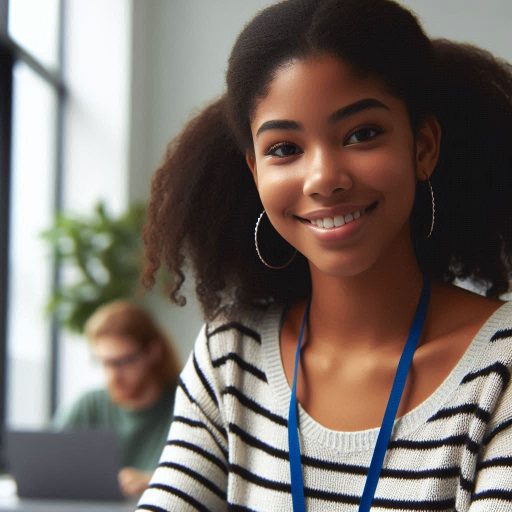Introduction
Creativity in Gifted Education: Gifted education is a specialized approach to teaching that caters to the needs of students who demonstrate exceptional abilities or potential in one or more areas, such as intellectual, creative, artistic, or leadership capacities.
These students often require educational programs that go beyond the standard curriculum to fully develop their talents and skills.
Creativity plays a crucial role in education, particularly in gifted education.
It is the ability to generate novel ideas, think divergently, and approach problems in innovative ways.
Creativity is not just about artistic expression; it’s about fostering critical thinking, problem-solving, and the ability to adapt to new situations.
In the context of education, encouraging creativity helps students explore and express their unique perspectives, leading to a deeper understanding of the world around them.
In gifted education, creativity is essential because it aligns with the advanced cognitive and emotional needs of gifted students.
These students often think outside the box and excel in environments where creativity is encouraged.
By integrating creativity into the curriculum, educators can provide gifted students with opportunities to explore complex ideas, engage in higher-order thinking, and develop their unique talents.
Benefits of creativity in gifted education
In gifted education, creativity plays a pivotal role in nurturing the full potential of students.
Beyond academic excellence, creativity fosters essential skills that prepare gifted learners for the complexities of the modern world.
By incorporating creativity into their education, we can enhance critical thinking, encourage problem-solving abilities, and foster innovative thinking—three crucial benefits that are indispensable for gifted students.
Enhancing Critical Thinking Skills
Creativity encourages gifted students to think beyond conventional boundaries.
By engaging in creative activities, such as brainstorming, mind mapping, or artistic expression, students learn to analyze problems from multiple perspectives.
This process of exploring different angles enhances their critical thinking skills, allowing them to make connections that others might overlook.
In gifted education, where students often encounter complex and abstract concepts, the ability to think critically is invaluable.
Encouraging Problem-Solving Abilities
Gifted students often face unique challenges that require advanced problem-solving skills.
Creativity in their education helps them approach problems with an open mind and a willingness to experiment with unconventional solutions.
Whether through creative writing, scientific inquiry, or hands-on projects, students develop the ability to identify problems, generate potential solutions, and evaluate outcomes.
This practice not only sharpens their problem-solving abilities but also builds resilience and adaptability—traits that are essential for success in any field.
Transform Your Career Today
Unlock a personalized career strategy that drives real results. Get tailored advice and a roadmap designed just for you.
Start NowFostering Innovative Thinking
Innovation is the hallmark of giftedness, and creativity is its driving force.
By fostering an environment that encourages creative exploration, educators can help gifted students push the boundaries of what is possible.
Creative activities inspire students to think outside the box, imagine new possibilities, and take intellectual risks.
This innovative thinking is not only beneficial for their personal growth but also contributes to advancements in various fields, making creativity a key component in the education of gifted students.
Read: Effective Classroom Management for ESL Teachers
Integrating creativity into the curriculum
Creativity plays a crucial role in the education of gifted students, fostering their intellectual and emotional growth.
Integrating creativity into the curriculum is essential to engage these students fully, allowing them to explore their potential and think beyond traditional academic boundaries.
Incorporating Project-Based Learning
One effective method to integrate creativity is through project-based learning (PBL).
PBL encourages students to engage in real-world problems and develop solutions creatively.
For gifted students, this approach allows them to dive deep into subjects they are passionate about, fostering a sense of ownership and motivation.
For example, a science project on renewable energy could lead students to design innovative solutions, blending creativity with technical knowledge.
Allowing for Open-Ended Assignments
Open-ended assignments are another way to nurture creativity in gifted education.
These assignments provide students with the freedom to choose how they approach a task, encouraging divergent thinking.
Unlike traditional assignments with set outcomes, open-ended tasks allow students to explore various possibilities, leading to unique and innovative results.
For instance, in a literature class, students might be asked to create a modern adaptation of a classic story, allowing them to express their creativity while demonstrating their understanding of the text.
Providing Opportunities for Self-Expression
Finally, providing opportunities for self-expression is vital in a creative curriculum.
Gifted students often have unique perspectives and ideas that need an outlet.
Whether through art, writing, or performance, allowing students to express themselves creatively can enhance their emotional intelligence and self-awareness.
For example, a poetry assignment that encourages students to explore their emotions and experiences can lead to profound insights and personal growth.
In a nutshell, integrating creativity into the curriculum through project-based learning, open-ended assignments, and opportunities for self-expression is essential for nurturing the potential of gifted students.
Read: How to Create Engaging Lesson Plans for ESL Students

Nurturing creativity in gifted students
Gifted students possess a unique ability to think outside the box, come up with innovative solutions, and see things from different perspectives.
It is crucial for educators to nurture and support this creativity to help these students reach their full potential.
Encouraging exploration and experimentation
One way to foster creativity in gifted students is by encouraging them to explore different topics and ideas.
Providing them with opportunities to experiment and try new things can help them unleash their creative potential.
For example, teachers can assign open-ended projects that allow students to choose their own topics and methods of investigation.
This freedom can lead to unexpected and creative outcomes that traditional assignments may not elicit.
Offering extracurricular activities in the arts
Another way to nurture creativity in gifted students is by offering extracurricular activities in the arts.
Whether it’s music, visual arts, theater, or dance, these activities provide an outlet for students to express themselves creatively.
Participating in the arts can help students develop their creative skills, learn to think creatively, and gain confidence in their abilities.
These experiences can also inspire them to think outside the box and approach problems creatively in other areas of their lives.
Providing workshops on creative thinking
Workshops on creative thinking can be a valuable tool for nurturing creativity in gifted students.
These workshops can teach students techniques for brainstorming, problem-solving, and thinking creatively.
Through these workshops, students can learn to think critically, analyze information, and generate innovative ideas.
They can also develop their ability to communicate their ideas effectively and collaborate with others to bring their creative vision to life.
Therefore, nurturing creativity in gifted students is essential for helping them reach their full potential.
By encouraging exploration and experimentation, offering extracurricular activities in the arts, and providing workshops on creative thinking, educators can help gifted students develop their creative skills and become innovative thinkers.
Read: Benefits of Being an ESL Teacher: Why Choose This Career?
Challenges in fostering creativity in gifted education
In gifted education, fostering creativity among students poses unique challenges that educators must address to ensure the full potential of gifted learners is realized.
Balancing creativity with academic rigor
One challenge in gifted education is finding the right balance between encouraging creativity and maintaining academic rigor.
Gifted students often have a thirst for knowledge and excel in traditional academic subjects, but may struggle to think outside the box or explore unconventional ideas.
Educators must create a learning environment that challenges students intellectually while also allowing them the freedom to express their creativity.
Addressing the needs of diverse learners
Gifted students come from a wide range of backgrounds and have different learning styles.
Some may thrive in a structured classroom environment, while others may need more flexibility and autonomy to unleash their creativity.
Educators must be sensitive to these differences and provide personalized learning experiences that cater to the unique needs of each student.
Overcoming traditional educational practices
One of the biggest challenges in fostering creativity in gifted education is overcoming traditional educational practices that may stifle creative thinking.
Many schools focus on standardized testing and rote memorization, which can limit the ability of gifted students to think critically and creatively.
Educators must be willing to think outside the box and implement innovative teaching strategies that promote creative thinking and exploration.
By addressing these challenges head-on, educators can create a learning environment that nurtures the creativity of gifted students and helps them reach their full potential.
Read: Common Challenges Faced by ESL Teachers and Solutions
Strategies for promoting creativity in gifted education
When it comes to nurturing creativity in gifted education, there are several effective strategies that educators can implement.
These strategies are crucial in helping gifted students reach their full potential and develop their creative abilities.
Here are some key strategies for promoting creativity in gifted education:
Implementing interdisciplinary approaches
Gifted students thrive on making connections between different subjects and disciplines.
By incorporating interdisciplinary approaches into the curriculum, educators can provide opportunities for students to explore complex topics from multiple perspectives.
This approach fosters creativity by encouraging students to think outside the box and make innovative connections between different areas of knowledge.
Collaborating with professionals in creative fields
One way to inspire creativity in gifted students is to connect them with professionals in creative fields such as artists, musicians, writers, and scientists.
By collaborating with these experts, students can gain valuable insights and mentorship that can help them develop their own creative talents.
This real-world interaction can spark new ideas and ignite a passion for creativity in gifted students.
Tailoring instruction to individual student needs
Gifted students have unique learning styles, interests, and strengths that require personalized instruction.
By tailoring lessons to meet the individual needs of gifted students, educators can create a supportive learning environment that nurtures creativity.
This customized approach allows students to pursue their interests, explore their passions, and express their creativity in meaningful ways.
All in all, promoting creativity in gifted education requires intentional strategies that support the unique needs and talents of gifted students.
By implementing interdisciplinary approaches, collaborating with professionals in creative fields, and tailoring instruction to individual student needs, educators can create a stimulating learning environment that inspires creativity and innovation in gifted students.
Evaluating creativity in gifted students
Using alternative assessments to measure creativity
When it comes to evaluating creativity in gifted students, traditional assessments may not be sufficient.
Gifted students often think outside the box and come up with unconventional solutions to problems.
This requires educators to use alternative assessments that can capture the depth and breadth of their creativity.
One way to measure creativity in gifted students is by using open-ended questions or tasks that allow them to showcase their innovative thinking.
These assessments could involve brainstorming sessions, creative writing prompts, or design challenges that test their ability to think creatively and solve complex problems.
Providing feedback on creative projects
Providing feedback on creative projects is another crucial aspect of evaluating creativity in gifted students.
Instead of focusing solely on the final product, educators should pay attention to the process and effort that went into the project.
Offering constructive feedback that highlights strengths and areas for improvement can help nurture their creativity and encourage them to take risks in their work.
Recognizing and celebrating creative achievements
Moreover, recognizing and celebrating creative achievements is essential for fostering a positive learning environment for gifted students.
By acknowledging their creativity and unique talents, educators can boost their confidence and motivation to continue exploring their creative potential.
This could be done through awards, showcases, or public recognition of their creative achievements.
Essentially, evaluating creativity in gifted students requires a holistic approach that goes beyond traditional assessments.
By using alternative assessments, providing feedback on creative projects, and recognizing and celebrating creative achievements, educators can support gifted students in reaching their full creative potential.
Conclusion
Creativity plays a pivotal role in gifted education, serving as a catalyst for unlocking the full potential of gifted students.
Unlike traditional educational models that often emphasize rote memorization and standardized testing, gifted education thrives on fostering creativity, allowing students to explore their unique talents and innovative ideas.
Creativity in gifted education encourages students to think outside the box, approach problems from multiple perspectives, and develop original solutions.
This approach not only enhances their cognitive abilities but also nurtures their emotional and social growth.
Incorporating creativity into gifted education involves providing students with opportunities to engage in activities that stimulate their imagination and critical thinking.




